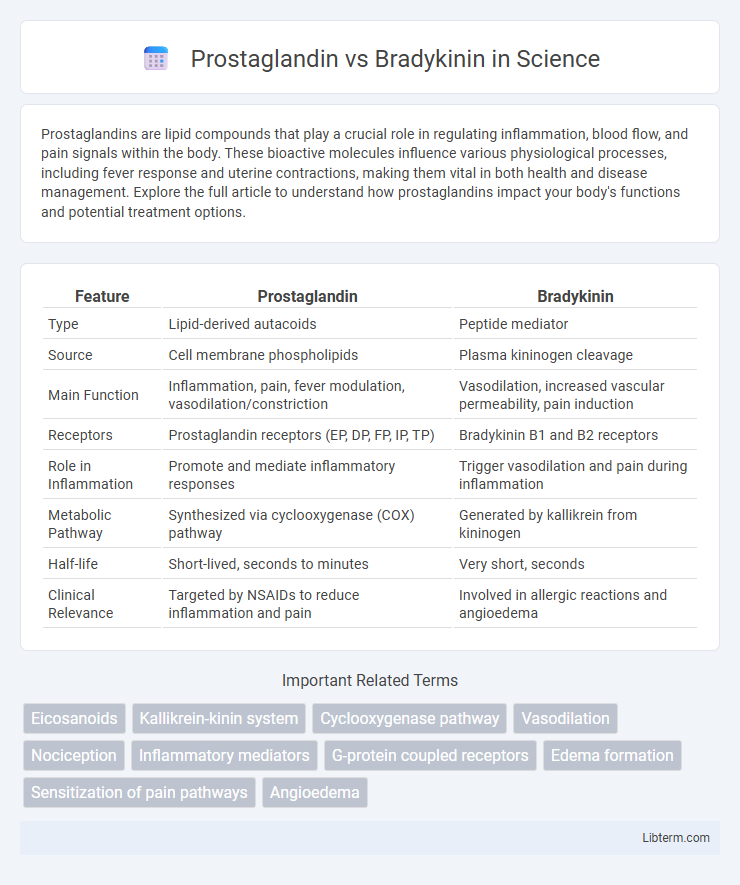Prostaglandins are lipid compounds that play a crucial role in regulating inflammation, blood flow, and pain signals within the body. These bioactive molecules influence various physiological processes, including fever response and uterine contractions, making them vital in both health and disease management. Explore the full article to understand how prostaglandins impact your body's functions and potential treatment options.
Table of Comparison
| Feature | Prostaglandin | Bradykinin |
|---|---|---|
| Type | Lipid-derived autacoids | Peptide mediator |
| Source | Cell membrane phospholipids | Plasma kininogen cleavage |
| Main Function | Inflammation, pain, fever modulation, vasodilation/constriction | Vasodilation, increased vascular permeability, pain induction |
| Receptors | Prostaglandin receptors (EP, DP, FP, IP, TP) | Bradykinin B1 and B2 receptors |
| Role in Inflammation | Promote and mediate inflammatory responses | Trigger vasodilation and pain during inflammation |
| Metabolic Pathway | Synthesized via cyclooxygenase (COX) pathway | Generated by kallikrein from kininogen |
| Half-life | Short-lived, seconds to minutes | Very short, seconds |
| Clinical Relevance | Targeted by NSAIDs to reduce inflammation and pain | Involved in allergic reactions and angioedema |
Introduction to Prostaglandin and Bradykinin
Prostaglandins are lipid compounds derived from arachidonic acid that play crucial roles in inflammation, pain, and regulation of blood flow. Bradykinin is a peptide that acts as a potent vasodilator involved in inflammation, pain signaling, and increasing vascular permeability. Both molecules function as local mediators but differ in their biochemical pathways and specific receptor interactions within the body.
Chemical Structure and Biosynthesis
Prostaglandins are lipid compounds derived from arachidonic acid via the cyclooxygenase (COX) pathway, featuring a characteristic 20-carbon skeleton with a five-membered ring. Bradykinin is a nonapeptide peptide consisting of nine amino acids, synthesized from kininogen through the action of kallikrein enzymes in the kallikrein-kinin system. The structural difference between the lipid-derived prostaglandins and peptide-based bradykinin dictates their distinct biosynthetic pathways and functional roles in inflammation and vascular regulation.
Physiological Roles in the Human Body
Prostaglandins regulate inflammation, pain perception, blood flow, and fever by acting as local hormones in various tissues, especially during immune responses and healing processes. Bradykinin primarily influences vascular permeability, vasodilation, and the sensation of pain, playing a key role in blood pressure regulation and inflammatory responses. Both molecules modulate smooth muscle activity and contribute to the body's defense mechanisms, but prostaglandins tend to have broader regulatory effects across multiple organ systems.
Mechanisms of Action
Prostaglandins exert their effects by binding to G-protein-coupled receptors, activating intracellular signaling pathways such as cAMP or calcium mobilization, which modulate inflammation, pain, and vascular tone. Bradykinin acts primarily through B1 and B2 receptors, triggering phospholipase C activation, increased intracellular calcium, and nitric oxide production, leading to vasodilation, increased vascular permeability, and pain sensation. Both mediators play crucial roles in inflammatory responses but engage distinct receptor systems and signaling cascades to produce their physiological effects.
Involvement in Inflammation and Pain
Prostaglandins play a crucial role in inflammation and pain by sensitizing nerve endings and promoting vasodilation, leading to redness, swelling, and increased pain perception. Bradykinin contributes to pain and inflammation by directly activating nociceptors and increasing vascular permeability, which facilitates leukocyte infiltration into inflamed tissue. Both mediators interact with specific receptors, triggering signaling pathways that amplify inflammatory responses and nociceptive signals.
Effects on Vascular Tone and Blood Pressure
Prostaglandins primarily cause vasodilation by relaxing smooth muscle cells in blood vessels, leading to decreased vascular tone and lowered blood pressure. Bradykinin also induces vasodilation but achieves this by stimulating the release of nitric oxide and prostacyclin, which further relax vascular smooth muscle and increase vascular permeability. Both compounds play crucial roles in regulating vascular tone, but prostaglandins act more directly on smooth muscle, while bradykinin operates through endothelial-dependent pathways.
Role in Disease and Disorders
Prostaglandins play a critical role in inflammatory diseases by mediating pain, fever, and swelling through the COX enzyme pathway, making them key targets in conditions such as arthritis and cardiovascular disorders. Bradykinin primarily contributes to vascular permeability and pain in inflammatory and allergic responses, significantly impacting disorders like hereditary angioedema and chronic inflammatory conditions. Both mediators influence disease pathology by modulating inflammation and vascular functions, but prostaglandins are more involved in chronic inflammation, whereas bradykinin predominantly triggers acute inflammatory episodes.
Pharmacological Modulation and Therapeutic Uses
Prostaglandins are lipid compounds modulated pharmacologically by nonsteroidal anti-inflammatory drugs (NSAIDs) which inhibit cyclooxygenase enzymes, reducing inflammation, pain, and fever. Bradykinin's effects are influenced by kininase inhibitors and bradykinin receptor antagonists, playing a critical role in vasodilation, pain mediation, and inflammation control. Therapeutically, prostaglandin analogs treat glaucoma, gastric ulcers, and induce labor, while bradykinin modulators are investigated for hypertension, hereditary angioedema, and inflammatory diseases.
Key Differences Between Prostaglandin and Bradykinin
Prostaglandins are lipid compounds derived from arachidonic acid that primarily mediate inflammation, pain, and fever by acting on specific receptors, while bradykinin is a peptide that induces vasodilation, increased vascular permeability, and pain through activation of B1 and B2 receptors. Prostaglandins are synthesized via the cyclooxygenase (COX) pathway and have diverse roles in processes like blood clotting and gastric protection, whereas bradykinin is generated through the kallikrein-kinin system and predominantly contributes to acute inflammatory responses and hypotension. The differing biosynthesis pathways, receptor targets, and physiological functions underscore the distinct roles prostaglandins and bradykinin play in inflammatory and cardiovascular regulation.
Clinical Implications and Future Perspectives
Prostaglandins and bradykinins play critical roles in inflammation and pain modulation, influencing therapeutic approaches for conditions such as arthritis and cardiovascular diseases. Clinical implications highlight the use of prostaglandin inhibitors like NSAIDs to reduce inflammation, while bradykinin receptor antagonists show promise in treating hereditary angioedema and inflammatory disorders. Future perspectives emphasize targeted drug development to modulate these pathways for personalized medicine, minimizing side effects and enhancing efficacy in chronic disease management.
Prostaglandin Infographic

 libterm.com
libterm.com